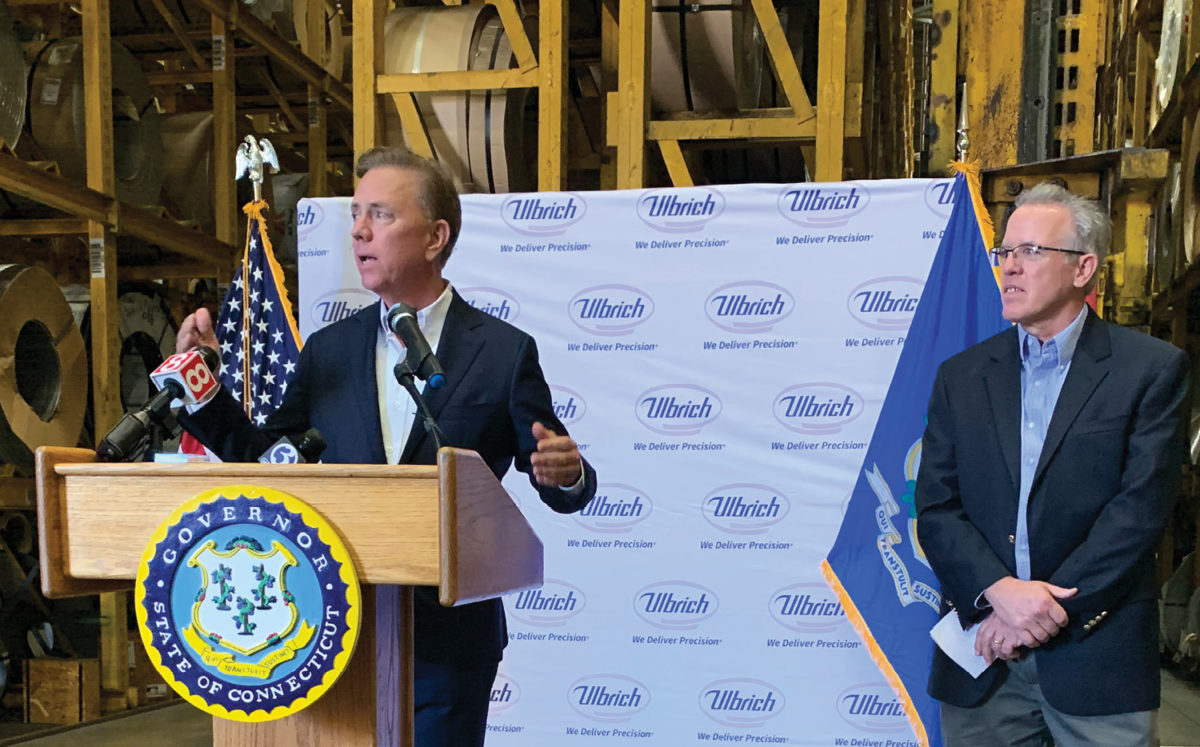Colin Cooper can be a master of the understatement.
“It”™s been an action-packed eight months or so,” Cooper, who became the state”™s first-ever chief manufacturing officer last fall, told the Business Journal.
“When I first started, I really tried to get out and about to the state”™s manufacturing community to talk to different stakeholders ”” business owners and other leaders ”” to get a sense of what the headwind issues were,” the former CEO of the Whitcraft Group in Plainville said.
Even with the arrival of Covid-19, however, Cooper said he”™s still trying to maintain contact with manufacturers large and small.
“The consensus out there ”” before the pandemic and now ”” is that there are three top problems: Workforce development, workforce development and workforce development,” he declared.
“If you go back to the 1970s, we had 300,000 people working in manufacturing in Connecticut. Now it”™s about half that number.”
The state”™s manufacturing sector employs nearly 161,000 people, or about 10% of Connecticut”™s total workforce, according to a report issued in November by the Connecticut Business & Industry Association and its affiliate, consulting firm CONNSTEP.

Twenty-five of the state”™s largest manufacturers, such as Sikorsky Aircraft (Shelton), Pratt & Whitney (East Hartford) and Electric Boat (Groton) represent about 60,000 of those employees, Cooper said.
Manufacturing firms pay over $14.9 billion in wages and contribute $30.8 billion to the state”™s economy each year; the average yearly salary is $96,279, well above Connecticut”™s $74,561 annual per capita income, according to the report.
Cooper said the CBIA”™s estimate of 4,011 manufacturing companies was probably still accurate, and noted that the median size of such firms is 25 employees.
How those numbers will shake out this year is anyone”™s guess, but Cooper noted that the state deemed manufacturing an “essential” business in the early going of the pandemic. Even so, some manufacturers have had to cut jobs: Whelen Engineering Co. recently let 17% of its workforce go, which included 98 people at its Chester facility.
But another of Cooper”™s attributes is a general sunniness. He noted that according to the Connecticut Department of Labor, the state added 1,100 manufacturing jobs in June, bringing that total number back up to 154,300.
“From an economic standpoint, manufacturing held up a lot better than some other sectors,” he said, noting that the hospitality sector was hit particularly hard.
“What was so great (during the pandemic”™s peak) was seeing a significant amount of new technology in the manufacturing sector,” he said. “So many companies were able to pivot and begin producing PPE, surgical and isolation gowns and other health-related equipment that we needed. Breweries and distilleries and chemical companies started making hand sanitizer, and we produced enough face shields to the point where we were exporting them to other states.”
Returning to workforce development, Cooper said that, pre-Covid, the sector was estimated to need 6,000 to 8,000 new entrants a year “for the foreseeable future” ”” and that Connecticut”™s capacity of training those people was about half of that.
Moving ahead, “We have to look at other avenues to get people trained to enter manufacturing,” he said. “Ten years or so back, high schools that had manufacturing programs went away because there was a perceived lack of demand for people with those skills.”
As the trend began to reverse, Cooper said, the state began investing in training facilities; today there are eight manufacturing centers at various community colleges as well as facilities at technical schools.
In addition to aging workers who are expected to retire over the next few years, “There is a significant amount of new technology we”™re all dealing with ”” not only in everyday life, but in the manufacturing sector as well.”
The problem, Cooper said, is that Connecticut”™s sprawling manufacturing sector is “a mile wide and an inch deep. We need to put resources behind upscaling some of our incumbent workforce, so that we can compete more efficiently in a worldwide market that”™s based on those skills and abilities.”
WHITHER THE MIF?
Even Cooper is hard-pressed to put a positive spin on what”™s happening with the state”™s popular Manufacturing Innovation Fund (MIF), which since its creation in 2014 has provided direct loans and/or grants to encourage a variety of training efforts, including for new and existing workers and apprenticeships.
The MIF has spent all but about $2.7 million of the $75 million allocated to it by the state government, Cooper said. About $5 million was diverted to the Manufacturing Voucher Program (MVP), which provides financial assistance to eligible Connecticut manufacturers, including matching grants of $5,000 to $50,000.
While there are no guarantees that more funding for the MIF will be forthcoming from a state government that is still assessing Covid”™s impact, Cooper said he has been in discussions with some legislators about how to keep it going through the second half of the year. Another potential source of funding has been identified, he added, though he would not provide details.
Meanwhile, one of Cooper”™s original remits was to persuade new companies to relocate to Connecticut. “We”™re still actively pursuing” such businesses, he said, “but obviously the focus of those talks is different than it was pre-Covid. In general, businesses right now are reluctant to make big decisions, until the fog lifts a little bit.
“But some of them really should invest now to capitalize on the current environment,” Cooper said.
He was also encouraged by Gov. Ned Lamont”™s recent creation of the Connecticut Workforce Development Unit, designed to establish policy and build a talent-to-jobs pipeline.
The office is headed by executive director Kelli Vallieres, who was on hand with Lamont earlier in July for the announcement of a $5.6 million investment to support advanced manufacturing and technology programs at Tunxis Community College in Farmington.
Although there is no formal connection between his and Vallieres”™ offices, Cooper said he was “happy to see that the state is still prioritizing investing in manufacturing.”
He also added that better days are ahead ”” for everyone.
“This is not a matter of dusting off the playbook,” Cooper said. “We”™re all dealing with situations that none of us have been in before.
“But even with all we”™ve seen over the last four months, I will submit that sometime in the future we will all look back and say, ”˜Never in human history have so many new initiatives been developed and implemented in such a short period of time.”™”

















ziprecruiter, indeed and others list the average pay for a manufacturing engineer in Connecticut in the low 80,000 range which is quite a bit less than the 96,000 listed as the average of everyone in manufacturing in Connecticut and I am under the impression that an engineer should make higher than the average worker. Most tool and die/CNC are in the 60k range at Lockheed(formerly Sikorsky) and job shops pay less. I love manufacturing but am not sure it is the road to riches that is indicated in this article